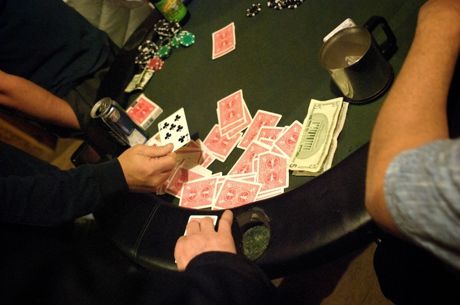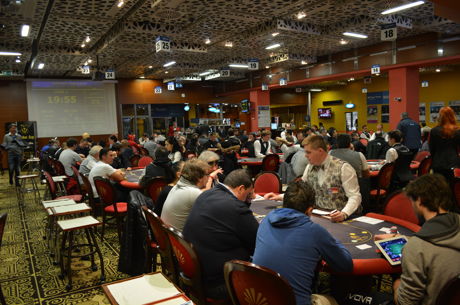Deciding When to Attack Cash Game Limpers

You're in a low-stakes cash game, one full of passive players many of whom are on the loose side. A hand arises in which you're in the cutoff, and three players limp in ahead of you. You look down at A♥J♥. What's your play?
I know, I know... it depends. What do I know about those three players who've limped? Who is on the button, and who is in the blinds? What are the stack sizes? What's my image to this point? You're a thinking player, and so you're asking all the right questions before jumping in with a response.
However, let's briefly consider the general situation, and address a larger question that often comes up in these kinds of games: When is it correct to attack the limpers?
Players who limp before the flop do so for a variety of reasons, although more often than not the action is an unambiguous sign of weakness.
Some sharp players will occasionally limp from early position with monsters, ready to pounce with a limp-reraise should someone raise behind them. That play can work in loose games, although isn't so recommended in a passive game in which an early limp is likely to be followed by more limps and a family pot.
You will also sometimes encounter especially timid players who will limp with strong hands, being generally disinclined to raise at all. Have you ever been in a low or "micro" stakes online poker game in which a preflop limper incredibly turns up with kings or even aces at the showdown? (It happens.)
Those exceptions aside, for the most part limpers are limping with medium-to-weak starting hands, primarily motivated by the hope of seeing a flop inexpensively.
Raising versus these types of limpers — especially with position — is generally a profitable play. If they fold, you win blinds, antes (if in play), plus their calls without a showdown. If they call, you'll get to play an even bigger pot with position against passive, often less-than-complicated opponents.
A problem arises, however, if you approach the idea of attacking limpers with raises with the same, uncritical approach they take when limping.
One big mistake players often make is to assume incorrectly all of those calls of the big blind automatically represent so-called "dead money" just waiting to be scooped up by a player willing to take advantage. The fact is, a decent percentage of players who make a habit of limping preflop will also tend subsequently to call raises, even when their hands and/or pot odds aren't necessarily suggesting such calls are smart to make.
A problem arises if you approach the idea of attacking limpers with raises with the same, uncritical approach they take when limping.
For that reason, the player looking to attack limpers with a raise often needs to have a hand worth raising. In fact, in certain situations versus multiple limpers your raising requirements in such a spot should go up quite a bit, representing an even more narrow range than the one with which you might choose to open-raise from late position.
That means having hands like big pairs or ace-king, and perhaps ace-queen or ace-jack (if suited). But truthfully a hand like A♥J♥ is going to be right on the line here, perhaps not worth raising when you face (1) the real possiblity of playing the hand versus multiple opponents, and (2) the additional likelihood your hand isn't even best among the field.
Having multiple callers of your raise with A♥J♥ is not a bad outcome, but in a multi-way situation postflop you'll be looking to make something more than just a big pair. Rather, you'll want to hit that flush draw, start building a Broadway straight, or make two pair or better to contend with a field of calling-station opponents.
Meanwhile think about raising a bunch of limpers with, say, A♣Q♥, then seeing a flop come Q♣9♠8♠. You might have flopped best, but you won't be eager to get more chips in the middle versus three or four opponents who after already showing a disinclination to fold may well have strong draws to something better (or may already have outflopped you).
Also important to keep in mind should you decide to attack limpers with a raise is the need to size your raise appropriately, making it large enough to discourage everyone from remaining in the hand. If you restrict yourself to strong starters as noted, you won't mind a single, sticky caller out of the bunch against whom your hand should play well in a heads-up situation. But as noted you can quickly get into an uncomfortable spot even with kings or aces if half the table calls your not-large-enough raise.
The situation is much different when there are only one or two habitual limpers at your table, and not a whole hoard of them. In such a situation you should raise more frequently to isolate, opening up your range a bit more than when raising versus a group of limpers — especially when playing from position.
Whenever a player limps before the flop in a cash game, take a mental note (or a literal one, especially if you're playing poker online) and closely consider that player's subsequent action after the flop, including paying attention to the player's hand if it reaches a showdown. Such players are usually passive and often tight, too, and if they show a tendency to abandon their hands postflop, they're the ones to attack most often with raises when they limp preflop.
When is it correct to attack the limpers? The answer isn't "always" — there are very few situations in poker where that is ever the right answer. But the answer isn't "most of the time" or "at every opportunity," either. Don't let the seemingly unthinking moves of opponents lull you into uncritical or autopilot-type plays yourself.









